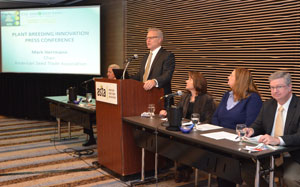 ASTA CSS in Chicago this week brought together a panel of experts to talk about the future of gene editing and it’s role in the agriculture industry.
ASTA CSS in Chicago this week brought together a panel of experts to talk about the future of gene editing and it’s role in the agriculture industry.
“Plant breeding is an evolving practice. It’s an evolving science.” said American Seed Trade Association President and CEO Andy LaVigne. “Plant breeding builds upon itself.” LaVigne outlined the milestones in plant breeding, beginning 10,000 years ago when man using selection breeding, all the way up to the new frontier of gene editing and precision breeding. Andy LaVigne, ASTA
Jerry Flint serves as the Vice President of Industry Affairs and Regulatory at DuPont Pioneer. He addressed CRISPR-Cas, a revolutionary plant breeding technique in which Pioneer is leading the way. “We need to continue to upgrade our toolbox in term of what’s avaialbe to plant breeders so that we provide the best tool and research development program to meet those growing needs,” Flint says. Jerry Flint, DuPont Pioneer
 Corinne Marshall introduced the application of gene editing in vegetables. As IP & Licensing Manager of Sakata Seeds America, Corinne sees advantages of the technology to increase nutrition in food, like helping broccoli retain nutrients lost in cooking or using watermelon to lower blood pressure. Corinne Marshall, Sakata Seeds America
Corinne Marshall introduced the application of gene editing in vegetables. As IP & Licensing Manager of Sakata Seeds America, Corinne sees advantages of the technology to increase nutrition in food, like helping broccoli retain nutrients lost in cooking or using watermelon to lower blood pressure. Corinne Marshall, Sakata Seeds America
Juliet Marshall, Associate Professor at the University of Idaho, explained how the CRISPR-Cas technology is different from GMOs. Her presentation showed how a simple deletion of one DNA code could enhance genes already present in the plant. Juliet Marshall, University of Idaho
In addition to developing the new technology, stakeholders will need to address consumer perception of gene editing and learn lessons from the backlash against GMOs. ASTA Chairman Mark Herrmann, CEO and President of AgReliant Genetics, said the industry is planning to “get out in front of the conversation.” Lavigne and Flint also weighed in on the need for transparency and consumer education efforts. Gene Editing and Consumers
Be sure to listen to the audio links for full comments from each of the presenters.


